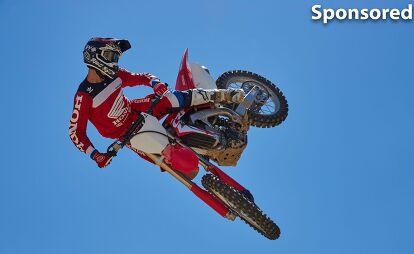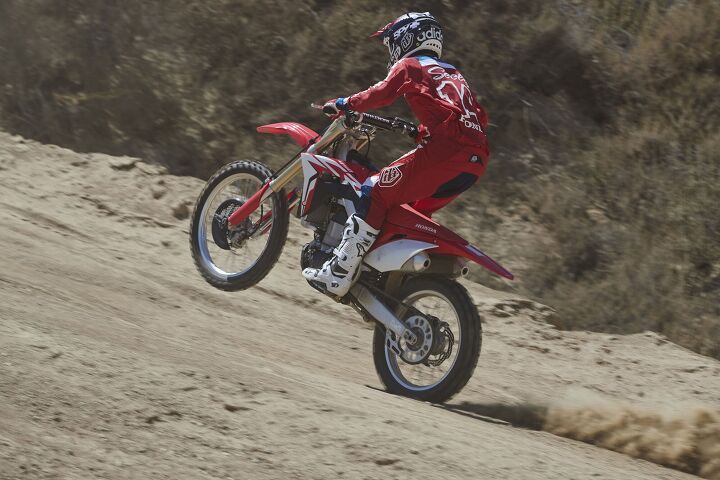Six Things To Love About Honda's CRF450R
No doubt about it, Honda’s all-new 2017 CRF450R has re-ignited the competition in the 450cc motocross class.
Thanks to a radically updated version of the CRF450R’s trademark liquid-cooled, fuel-injected Unicam engine, an entirely new aluminum perimeter chassis, a new Showa fork that replaces the previous air-sprung system with more traditional, easy-to-tune coil springs, and the latest Pro-Link rear suspension, the CRF450R has vaulted back to the front lines of the 450cc wars with a vengeance. For Honda fans, the new CRF represents the most exciting 450 yet, and it’s a machine that is sure to win over riders of other brands. Honda’s “Absolute Holeshot” design goal means the new CRF450R boasts an aggressive power delivery that can be tailored with a press of the innovative Engine Mode Select button. There really are a lot of reasons to love the 2017 CRF450R, here are six of them:
ONE: HONDA ENGINE MODE SELECT BUTTON
Unless your last name is Roczen or Seely, chances are that you will not be able to use the 2017 CRF450R’s potent Unicam engine to its full potential. In the face of ever-increasing power levels, 450cc motocross bike manufacturers have been utilizing various systems that allow riders to tailor power output to suit varying riding styles and track conditions for the past few years, but Honda’s Engine Mode Select button system takes this important function to a new level by making it simpler than ever.
The Engine Mode Select button allows the rider to select from among three EFI/ignitions maps stored in the Engine Control Unit virtually on the fly, simply by pressing a button mounted on the left side of the handlebar—no need to pull back into the paddock to swap plug-style ignition modules or miss out on precious track time while hooking up a hand-held unit to adjust individual fuel map parameters. The Honda’s default mode contains the stock ignition map, but there are two more modes available for customized maps that can be reprogrammed via an HRC accessory tuning tool. Mode 2 tames the power delivery across the rev range for greater tractability on slick off-road surfaces, wet or dry, while Mode 3 unleashes the full aggression of the Honda’s engine to help the CRF easily churn through deep surfaces or other conditions where traction is abundant.
Honda first introduced the Engine Mode Select button system in 2015, but the 2017 CRF450R features a significant upgrade by incorporating the engine kill switch and the Engine Mode Select button into a single compact unit.
TWO: SHOWA COIL-SPRING FORK
Forks that use compressed air in place of conventional coil springs have been the rage in motocross of this decade, but what works best for factory race teams doesn’t always translate to the average consumer. In an affirmative response to overwhelming customer demand, the 2017 Honda CRF450R makes a welcome transition away from the 48mm KYB Pneumatic Spring Fork to an all-new 49mm Showa coil spring fork that meets the harsh performance demands of motocross while remaining hassle-free at the track.
Most importantly, the new, fully adjustable Showa fork does away with the need for the high-pressure air pump that is necessary to “tune” an air fork for a desired spring feel. Also, unlike air forks, coil spring forks are not sensitive to changes in temperature or altitude. And what little the new Showa fork yields in added weight when compared to the previous air fork is more than mitigated by outstanding performance that is highlighted by increased sensitivity over rough ground, a common challenge with air forks. Rest assured that Honda engineers didn’t achieve this tremendously improved feedback by specifying pedestrian components in the new fork. Instead, the new Showa boasts the same internal specifications featured in the company’s “A-Kit” factory race suspension to deliver 12 inches of suspension travel that is supple yet controlled over any terrain.
Naturally, Honda’s R&D crew performed extensive testing on the new fork prior to spec’ing it on the 2017 CRF450R. The verdict? Not only is the Showa fork easier to set up and maintain than the KYB PSF it replaces, but the Showa also outperforms the KYB in every aspect.
THREE: HOLESHOT PERFORMANCE
Aside from taking the checkered flag, just about any motocross racer will tell you that the most important part of the race is the first few seconds after the gate drops. Thanks to a number of upgrades, including a new cylinder head layout, a new downdraft intake system, increased compression and more radical camshaft profiles, the CRF engine easily belts out 60 usable horsepower at the crankshaft. Simply put, it’s the most responsive, most aggressive-feeling CRF450R engine in the model’s history, and that can equate to more holeshots and a better finishing position when the checkered flag falls.
The higher-winding 2017 CRF450R engine makes exhilarating yet surprisingly linear power and torque throughout its rev range, delivering 9.8-percent greater power-to-weight ratio (2.623 lbs./hp vs. the 2016’s 2.365 lbs./hp) than the 2016 CRF450R engine. Honda engineers achieved this more exciting engine character via numerous upgrades, including an all-new SOHC cylinder head with a new valve train arrangement that features a 2mm narrower valve angle and finger followers between the intake lobes and the intake valve stems, whereas the previous engine’s intake valves were bumped directly by the intake lobes. A single, forked rocker arm with a DLC (Diamond-like carbon) coating still opens the exhaust valves. The new valve train design also features an F1-style finger follower, allowing Honda engineers to overcome a previous design limitation while installing a more aggressive cam with .5mm more lift (now 10mm lift) on the intake lobes and .85mm more lift (8.8mm lift) on the exhaust lobe.
The CRF’s new oval cross-section valve springs are better than conventional springs because they can handle higher loads and also offer reduced spring height at a given stroke, which makes it easier to make the valve train more compact. Additionally, the new springs made it easy to lower the CRF450R’s overall engine height, making the engine more compact. The 38mm intake valves are 2mm larger than the previous valves and are machined for smoother gas flow into the combustion chamber. They give the 2017 CRF450R 19 percent greater intake efficiency. Flow on the exhaust side is also 10 percent greater than on the 2016 model.
Even more power was achieved via a new combustion chamber that gives the CRF450R a revised squish band for better mixing of the intake charge inside the cylinder, and a new piston helps to raise the compression ratio to 13.5:1, a full point higher than the 2016’s compression ratio. Since increased compression generates more heat, Honda revised the CRF450R’s oil jet system, which cools the underside of the piston. The new jet features a four-hole piston rather than a two-hole piston for better oil distribution which is intended to reduce the piston temperature more effectively and increase reliability.
Speaking of oil the 2017 CRF450R also receives a revised oiling system with a new dual-stage scavenge pump that reduces pumping losses for greater efficiency. It also allows for a reduction in total oil volume from 1490cc to 1250cc to decrease weight inside the engine.
The net result is a lighter, more robust engine that pulls like a freight train while retaining Honda’s signature tractability and smooth, precise throttle response. So what’s not to like?
FOUR: TITANIUM FUEL TANK
The 2017 CRF450R’s 1.6-gallon (6.3 liter) fuel cell is the most exotic tank ever to be used on a production motocrosser, as it is now made of titanium. The added cool factor and weight savings are already huge bonuses, but the tank is also contoured to make it narrower than the 2016 model’s 1.7-gallon unit for better ergonomics, allowing the rider greater freedom of movement and better control on the track.
True, the 2017 CRF450R weighs 243 lbs. (110.1 kg), exactly the same as the 2016 by Honda’s own measuring standards, but the difference is that the lighter tank, combined with a redesigned aluminum chassis significantly lowers the CRF450R’s center of gravity, honing its razor-sharp handling characteristics to an even finer point. Light is right!
FIVE: LIGHTER, MORE RESPONSIVE FRAME
The first thing you notice when climbing aboard the 2017 CRF450R is how much smaller and narrower it feels than the 2016 model. Savvy motocross riders will also notice the greater length and more gradual curves of the 2017 CRF’s aluminum perimeter frame spars and how they are thicker near the steering head but thinner as they move toward the swingarm pivot.
This careful crafting has given the CRF decreased torsional stiffness for a more forgiving, compliant and confidence-inspiring flex character when the going gets rough, but the CRF450R’s lateral stiffness is unchanged, delivering the lightning-quick steering response that motocross riders have praised since Honda introduced the first aluminum perimeter chassis on the 1997 CRF250R. At the same time, the chassis boasts a slight rake increase for increased stability—enough that the 2017 CRF450R does away with 2016 CRF’s Honda Progressive Steering Damper (HPSD) without sacrificing straight-line tracking through ruts, whoops and over jumps.
And while the 2017 CRF450R chassis raises the CRF’s airbox and intake tract to create a downdraft layout that gives the incoming air charge a straighter shot through the Honda’s ultra-precise 46mm Keihin PGM-FI throttle body and into the engine for more power, the overall lower center of gravity of the new chassis helps make the 2017 CRF450R the best handling Honda motocross bike ever.
SIX: MASS CENTRALIZATION
Make a motorcycle more compact and you’ll make it easier to ride. Honda pulled out all the stops with the 2017 CRF450R to shrink the envelope as much as possible. A new aluminum subframe with extruded gussets is not only 20 percent lighter, but it is also shorter and narrower from top to bottom. The more compact chassis also places the CRF’s shock lower in the chassis to clear the intake tract without sacrificing rear suspension travel. The CRF’s new, lighter Pro-Link aluminum swingarm is 5mm shorter than the previous version while also being stiffer both laterally and torsionally, resulting in a more rearward weight bias that increases rear wheel traction to propel the CRF450R forward quicker and with a more sure-footed feel than ever before.
Honda also fitted the 2017 CRF450R with a more compact version of its instantly recognizable dual-muffler exhaust system, which helps to further concentrate the bike’s overall mass by incorporating 78mm shorter mufflers. As an added benefit the new exhaust system also features pipes with more gradual bends to improve exhaust flow, yet another way that helps the Honda achieve its authoritative power character.
The 2017 Honda CRF450R’s holeshot-stealing power, precise handling and bump-eating suspension performance make it a serious 450cc MX class contender that appears bound for glory, whether on the AMA National motocross and supercross circuits or in weekly amateur motocross competition. We’ve just cited six reasons why, and there’s a lot more than that. The bottom line is that Honda is back in a big way. Don’t be surprised if you see a “red tide” of 2017 CRF450Rs swarming your local motocross track this year while its off-road CRF450RX sibling ups the ante in the cross-country and enduro worlds.
More by Sponsored
























































Comments
Join the conversation
So titanium is lighter than a plastic tank? And a single muffler would probably save about 3 lbs instead of the dual mufflers correct?
And how come there arent that many well known Asian Dirt riders. I think it's funny that these bikes are engineered by asian people yet the main demographic are mainly whites.
No street supermoto or streettracker versions= fail. It's just an opinion, a minority opinion admittedly.